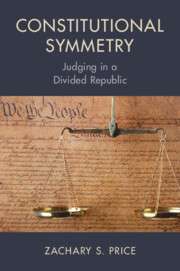The Volokh Conspiracy
Mostly law professors | Sometimes contrarian | Often libertarian | Always independent
Symmetry in Equal Protection, Fundamental Rights, and the Law of Democracy

My last post offered examples of areas where symmetry could help guide future doctrinal development. This final post on my book addresses three of the most fraught areas of constitutional law: equal protection, fundamental rights, and the law of democracy. In all these areas, as in the others I already addressed, highlighting symmetric possibilities makes clear that framing constitutional debates in maximally rivalrous terms is a choice; less polarizing options are available too.
Regarding equal protection, questions of group identity and legal equality are obviously a major point of ideological division in the contemporary United States. The conservative constitutional vision understands the Fourteenth Amendment's Equal Protection Clause to require a strict "colorblind" focus on individual characteristics rather than group identities. By contrast, the progressive vision interprets the same guarantee to allow, or perhaps even require, governmental privileging today of groups who suffered discrimination and disadvantage in the past.
Even as the divide between these perspectives has grown more acute in American society, the Supreme Court has aligned itself more squarely with the conservative vision. It thus held in Students for Fair Admissions, Inc. v. President and Fellows of Harvard College (SFFA) in 2023 that racial preferences in higher education are unconstitutional.
The Court could mitigate this asymmetry in at least three ways going forward. One would be to restore what I call "Bakke with bite": the Court could hold, much as it did in earlier cases such as Regents of the University of California v. Bakke and Grutter v. Bollinger, but with greater rigor, that public universities and other government programs may pursue "diversity" so long as they do so in an individualized rather than mechanical fashion. A second option, which I call "counter-majoritarian majoritarianism," would follow John Hart Ely in holding that majorities may discriminate against themselves by adopting preferences for historically disadvantaged minorities, but only if the majority in question genuinely dominates the institution or level of government at issue. Finally, a third option, which I call "consciousness without classification," would follow Justice Kennedy's concurrence in Parents Involved in Community Schools v. Seattle School District #1 and allow governments to select criteria for benefits and programs with a view to their demographic effects, but only if the criteria themselves operate without regard to any individual's demographic characteristics.
As the book notes, all these options carry benefits and drawbacks, and none follows ineluctably from primary interpretive considerations of text, history, and precedent. Yet all at least have the virtue of greater symmetry as compared to either inflexible colorblindness or full-bore pursuit of group preferences, and while SFFA may militate against all these approaches, it does not entirely foreclose them.
On the question of fundamental rights, the book defends the method of rights identification advanced by the Supreme Court in Washington v. Glucksberg and applied more recently in the Dobbs decision overturning Roe v. Wade. Under this method, courts identify unenumerated fundamental rights by asking whether the right in question, defined at a relatively low level of generality, is "deeply rooted in this Nation's history and tradition and implicit in the concept of ordered liberty."
The majority opinion in Dobbs was ambiguous about whether this "history and tradition" inquiry applies on an evolving basis with reference to contemporary laws and practices or instead with a backward-looking focus on laws and practices in place when the Fifth or Fourteenth Amendment was adopted. In an important concurrence, however, Justice Kavanaugh (who was an essential fifth vote for the majority) emphasized that "the Constitution does not freeze the American people's rights in 1791 or 1868." If (but only if) the Glucksberg inquiry operates as Justice Kavanaugh proposed, then it is symmetric: it grants both progressives and conservatives an equal opportunity to shape the Court's future jurisprudence by advocating measures in the political process that may eventually congeal into constitutionally protected rights.
Defending Glucksberg as symmetric may seem surprising given the polarization surrounding Dobbs and the abortion question. But honest application of Glucksberg, as understood by Justice Kavanaugh, could easily support recognition of rights favored by progressives in the future. It could even end up supporting a right to abortion if state laws continue trending in that direction.
Indeed, even now, Glucksberg arguably supports a right to abortion when a pregnancy seriously threatens the life or health of the mother. After all, even the most restrictive abortion laws typically include such exceptions, and that understanding accords with broader legal protections for bodily autonomy reflected in self-defense standards and the like.
In addition, at least one traditional area of unenumerated rights protection is itself strongly symmetric. For nearly a century, the Supreme Court has understood the Fourteenth Amendment to protect parental rights, meaning the authority of parents rather than the government to make basic choices regarding their children's upbringing. That right is effectively symmetric today because Republican "red" states and Democratic "blue" ones have threatened parental autonomy from diametrically opposite directions on questions such as treatment of gender dysphoric children.
The book also discusses the law of democracy in a last substantive chapter. Although symmetry has obvious relevance to constitutional questions relating to electoral procedures, applying the concept in this area is tricky because political divisions are dynamic and in some ways a product of the very rules that symmetric interpretation might aim to adjust.
Applying symmetry in this area, the book defends the Court's choice to leave political gerrymandering to the political process. By declining to impose federal constitutional limits on gerrymandering but also allowing states to regulate it if they so choose, the Court has allowed the relatively even nationwide contest between not only Democrats and Republicans but also proponents and opponents of gerrymandering to continue unfolding through the political process. Given districting's complex partisan effects and the technical challenges in regulating it, that result may be the best the Court can do in terms of symmetry. At the same time, the book argues that courts should be on guard against electoral rules that systematically disadvantage one coalition or the other. Such rules, if they genuinely have such effects, reflect precisely the sort of repressive tendency that symmetric interpretation seeks to limit.
The book (though relatively short!) offers greater detail on all these points; here, I have only sketched my conclusions in compressed form. Even if my claims about what positions are symmetric fail to persuade, my primary goal in the book is simply to show how reframing the debates in these terms could help break the logjam of our current constitutional partisanship.
In closing, let me note, as the book's conclusion also does, that we should not exaggerate the United States's challenges. Despite our bloody civil war and regular betrayals of our founding values, the U.S. Constitution has been remarkably successful: political scientists often point to it as an international gold standard of regime stability and democratic continuity.
The country's very stability, however, may have led citizens to take its constitutional bedrock for granted. At any rate, political actors seem to presume that pushing aggressively for immediate victories poses no threat to the constitutional structure as a whole. Symmetric interpretation aims to forestall the risks such behavior creates by deflecting political conflicts, when possible, away from constitutional law and back into the political process.
Thanks again to Eugene and the Volokh Conspiracy bloggers for hosting these posts, and thanks to all of you for reading!
Editor's Note: We invite comments and request that they be civil and on-topic. We do not moderate or assume any responsibility for comments, which are owned by the readers who post them. Comments do not represent the views of Reason.com or Reason Foundation. We reserve the right to delete any comment for any reason at any time. Comments may only be edited within 5 minutes of posting. Report abuses.
Please to post comments




This book is a misuse of the term "symmetry".
Symmetry in equal protection, fundamental rights, and the law of democracy ensures that all individuals are treated with fairness and consistency under the law, upholding the core principles of justice and equality. This concept is critical in protecting the rights of marginalized groups and maintaining a balanced democratic process. Just as tools like the Yes/No Picker Wheel (https://yesnopickerwheel.com/) simplify decision-making by providing unbiased outcomes, symmetry in these legal frameworks promotes impartiality, ensuring that laws and policies apply equally to all citizens, fostering trust and equity in democratic governance.
Symmetry in equal protection, fundamental rights, and the law of democracy ensures that every individual is treated with fairness, dignity, and equality under the law. This principle promotes balance in how rights are granted and protected, regardless of race, gender, or social status. It plays a critical role in upholding democratic values, ensuring that no group faces discrimination or unequal treatment. For instance, just as platforms like CarX Street (https://carxstreetpreapk.com/) provide equal access to immersive gaming experiences for all users, the law of democracy aims to offer equal opportunities for participation, representation, and protection of rights for every citizen, fostering a just and inclusive society.
Symmetry in Equal Protection, Fundamental Rights, and the Law of Democracy plays a crucial role in ensuring fairness and justice across various legal frameworks. It demands that laws treat individuals equally and protect their fundamental rights, ensuring that no one is unfairly disadvantaged or denied participation in the democratic process. For example, the concept of symmetry can be observed in platforms like Kinemaster (https://kinemaster.shop/), which provides equal access to tools for users regardless of their background, enabling them to create high-quality content and express their ideas freely. Such principles ensure that democratic rights and opportunities are accessible to all, reinforcing the core values of equality and fairness.
Symmetry in Equal Protection, Fundamental Rights, and the Law of Democracy plays a crucial role in ensuring fairness and justice across various legal frameworks. It demands that laws treat individuals equally and protect their fundamental rights, ensuring that no one is unfairly disadvantaged or denied participation in the democratic process. For example, the concept of symmetry can be observed in platforms like Avatar World Game (https://avatarworldmodapk.org/), which provide equal access to immersive gaming experiences for all users. Such principles ensure that democratic rights and opportunities are accessible to all, reinforcing the core values of equality and fairness.
Symmetry in Equal Protection, Fundamental Rights, and the Law of Democracy plays a crucial role in ensuring fairness and justice across various legal frameworks. It demands that laws treat individuals equally and protect their fundamental rights, ensuring that no one is unfairly disadvantaged or denied participation in the democratic process. For example, the concept of symmetry can be observed in platforms like Telegram (https://talegrammodx.com/), which provides equal access to tools for users regardless of their background, enabling them to create high-quality content and express their ideas freely. Such principles ensure that democratic rights and opportunities are accessible to all, reinforcing the core values of equality and fairness.
The Vedu App download process is simple and designed for users who want quick access to entertainment on their devices. Once installed, the app offers a seamless interface where movies, shows, and other multimedia content are easily accessible. With lightweight installation requirements, it doesn’t take up much storage space, making it ideal even for devices with limited memory. The straightforward download ensures that anyone can set it up without technical hurdles here https://veduappsdownload.com/
For sports lovers who never want to miss a moment of the action, Sportzfy is a game-changer. It delivers high-quality live streams, highlights, and updates directly to your device, turning every game into a front-row experience. Whether you’re at home, commuting, or traveling, Sportzfy keeps you connected with the thrill of the game. With its reliable service and wide coverage, it’s quickly becoming a go-to choice for passionate fans who crave nonstop excitement here https://sportzfydownloads.com/